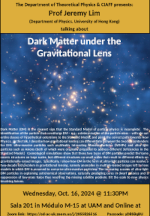Dark Matter (DM) is the clearest sign that the Standard Model of particle physics is incomplete. The identification of the particle that constitutes DM – e.g., a determination of the particle mass – will rule out entire classes of hypothetical extensions to the Standard Model, and point the correct path towards New Physics. In this talk, I describe how gravitational lensing can differentiate between the two top contenders for DM: ultra-massive particles such as Weakly Interacting Massive Particles (WIMPs) and ultra-light particles such as Axions (both of which were originally proposed to address different deficiencies in the Standard Model.) Cosmological simulations show that these two types of DM particles predict the same cosmic structures on large scales, but different structures on small scales that result in different effects on gravitationally-lensed images. Specifically, I show how DM in the form of ultra-light particles can resolve a two-decade old problem in gravitational lensing, namely anomalies in multiply-lensed images left by lens models in which DM is assumed to comprise ultra-massive particles. The increasing success of ultra-light DM particles in explaining astronomical observations, naturally predicting cores in dwarf galaxies and a suppression of low-mass halos thus resolving the missing satellite problem, tilt the scale to new physics involving Axions.

